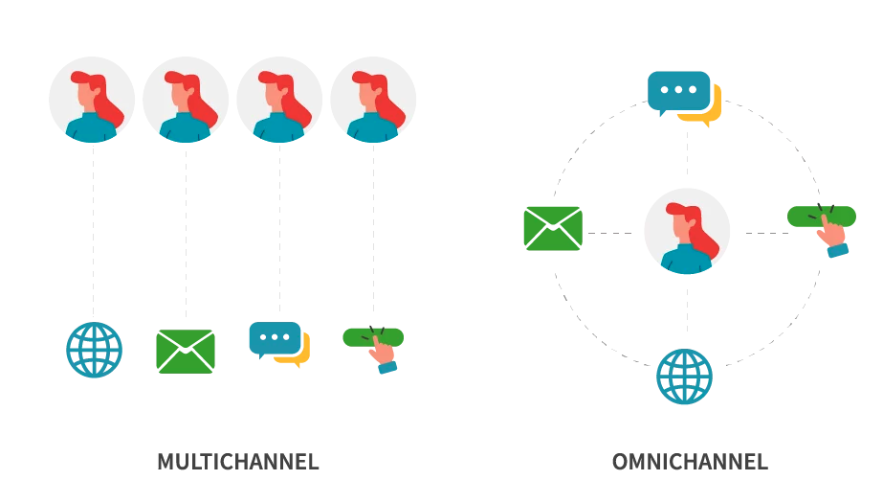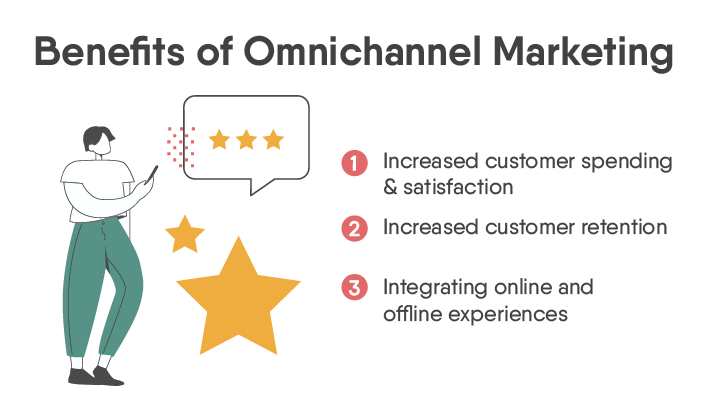What Is Omnichannel Marketing, and How Does it Help Retail Businesses?
It’s no longer business as usual for traditional brick-and-mortar retailers; many are rapidly losing customers to those who have adapted to modern consumers’ expectations.
Today, consumers seek contemporary conveniences. The modern consumer expects a seamless shopping experience that meets them across the multiple digital channels, devices, and platforms they frequent.
To be successful, retailers must adopt a marketing strategy that puts the customers of today at the front and centre of business. That strategy is omnichannel marketing.
With the omnichannel marketing approach, retailers can drive a better customer experience and growth for their businesses by offering various marketing channels to see customers through their buying journey.
An HBR survey found that, out of 46,000 shoppers sampled, an overwhelming 73% opted for an omnichannel shopping experience over in-store or online only.
As expected, meeting your customers’ expectations pays off, too; businesses who use an omnichannel strategy see 91 % % greater year-over-year customer retention rates over businesses that don’t.
Strap yourself in as we go over this concept and its benefits for retailers.
What is omnichannel marketing?
Omnichannel marketing is a strategy that seeks to provide customers with a seamless and consistent experience, whether they’re interacting with a company online, in-store, or through any other channel.
The aim here is to create a cohesive customer journey that lets customers move fluidly between channels without losing track of their journey or becoming frustrated. To achieve this, businesses need to have a clear understanding of their customer base and what channels they deploy to interact with them.
They also need to ensure that they’re communicating a consistent message across all channels and that each touchpoint is integrated seamlessly.
What is omnichannel vs. multichannel?
Omnichannel marketing is often used interchangeably with multichannel marketing. Though they’re similar, they each have a different endgame.
Multichannel marketing refers to the use of multiple channels to reach and engage customers. This could include things like having a presence on social media, having a website, using email marketing, and using print collateral.
The goal of multichannel marketing is to increase brand awareness through multiple channels and make it easy for customers to engage with your brand how they want to.
Omnichannel marketing takes things one step further by creating an integrated experience for customers no matter how they choose to engage with your brand. This means that whether they interact with you online, in-store, or through a mobile app, they will have a consistent experience that is tailored to their individual needs.
The goal of omnichannel marketing is to provide customers with a personalised experience that meets them where they are.
While both multichannel and omnichannel marketing strategies have their own advantages, omnichannel is quickly becoming the preferred approach for many businesses. This is because it provides a more seamless and customised experience for customers, leading to increased brand loyalty and customer lifetime value.
If you want to create a more immersive and engaging customer experience, then an omnichannel marketing strategy is the way to go.

Why is omnichannel marketing important?
The omnichannel approach is proving more productive as marketers have recorded a 250 %% higher engagement and purchase rate with multiple channels than with a single channel.
Perhaps the most crucial reason why omnichannel marketing comes highly recommended is the scalability of sales that it affords retailers. Plus, in cases of abandonment, rather than have to repeat processes from the start, customers can switch across channels or devices and continue their customer journey.
Let's give a relatable example:
Sarah wants to purchase a pair of shoes from A-brand. She has access to an email, a mobile phone, a laptop, and her social media accounts. All these channels would help her achieve the end goal — purchasing a pair of shoes — through the omnichannel model.
In an omnichannel loop, Sarah starts a quick search with her laptop about the shoes on Google. Her mobile phone location is on and directs her to the nearest in-store location to grab her shoes whenever she’s ready to purchase. She goes on social media to hear what customers are saying about the shoes and proceeds to place an order via her phone.
Then, rather than request a doorstep delivery, Sarah goes to the nearest A-brand store to pick up her order. On getting home, she receives a personalised email thanking her for her purchase, plus recommendations for other shoes that she might love.
From this illustration, the buyer starts the customer journey online and ends in-store. Sarah doesn't have to learn about the shoes online, only to get to the in-store, and the salesperson repeats the process of trying to sell or wait around. She already knew what she wanted, placed an order, and then went to pick it up from the store and back home.
This is a typical example of how effective an omnichannel marketing system can be. Of course, there’s no one-size-fits-all to this as many retailers apply different forms of the omnichannel strategy, as long as it suits the business and satisfies the customers.
Companies that have built a solid omnichannel marketing approach
It's no surprise that companies are now gearing towards adopting omnichannel marketing for increased business growth and customer retention. Here’re a few companies that have built solid omnichannel marketing frameworks and integrated them into their services.
Amazon:
Amazon is known to used to be an online-only, single-channel retail store. Upon integrating an efficient omnichannel model into its marketing, Amazon now allows its customers to order items online and pick them up in-store if they wish.
What’s more, their website is accessible across various mobile phones, laptops, smartwatches, and Alexa devices, with an Amazon card usable anywhere in the world. These features and more makes their user interface frictionless and contribute to a seamless experience for the customers.
Walgreens:
Walgreens is another store that has invested in the omnichannel approach for its services. It is a health and wellness pharmaceutical store that makes keeping your health in check exciting and rewarding. It implements a cash rewards system, where customers get paid back a certain percentage of the money spent in their stores.
It also awards points for partaking in certain activities like purchasing online and in-store, filling out health-related surveys, getting vaccinations in their stores, and many more. The collation of these points can be converted to cash or used to purchase products from the store.
With the omnichannel approach, Walgreens took health care to the next level and has made its customers proactive in making health decisions owing to these features.
Benefits of omnichannel marketing for retail businesses
By catering to the investigative mindset of customers across multiple touchpoints, retail businesses stand to gain a lot. Here are a few bottom-line boosting benefits of omnichannel marketing for retail businesses.

Increased customer spending & satisfaction:
According to research published in Harvard Business Review, consumers who connect with a company over several channels spend an average of 10% more than single-channel customers both in-store and online.
The same Harvard research found that customers who purchase across many categories return more often. Over six months, consumers who interacted with brands across several platforms made 23% more in-store purchases.
Increased customer retention:
If your customers enjoy shopping with you, they are more likely to stick with you. With omnichannel marketing, customers can now shop conveniently without entering a repeated loop every time, giving them one less reason to shop from competitors.
Integrating online and offline experiences:
Omnichannel marketing allows you to integrate your customers' online and offline experiences. This feature allows your customer to reach out online and physically whenever they wish.
Also, they are enabled to begin transactions online and end them offline or vice-versa. This feature grants your customers numerous options to choose from regarding their purchase without having to compromise any.
Streamline your omnichannel presence with APSIS ONE
A sure way to drive customer lifetime value and accelerate customer acquisition, omnichannel is key to long-term growth for modern retailers as it puts the shopper at the heart of marketing (customer-focused rather than channel-centric).
Shoppers can shop on their terms and purchase items how, when, and where they want. As such, we at APSIS have worked relentlessly to innovate marketing technology with built-in functionalities that optimise offline and online outcomes for retail businesses. By fusing these touchpoints, many of our partners in the retail industry have been able to leverage a seamless brand experience to grow their bottom line.
For more insight into the true, transformational powers of omnichannel strategy, we’ve created this whitepaper to walk you through all you need to turn your vision for an omnichannel marketing framework into reality.
Want to explore the many ways you can use these omnichannel-friendly capabilities to string together the multiple pieces of your marketing operations? Book a demo today!






